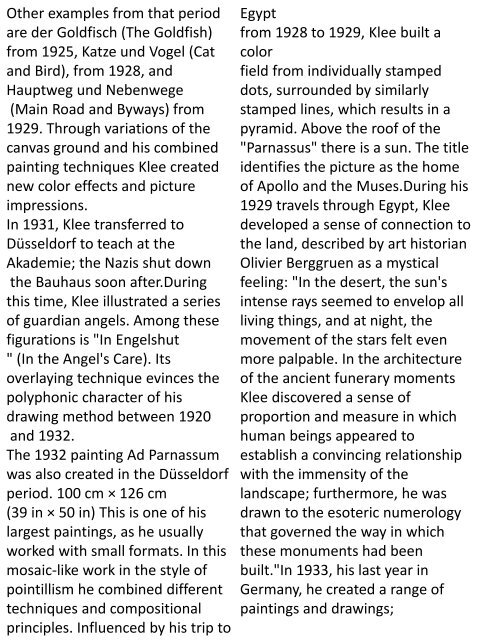Aziz Art July 2019
History of art(west and middle east)- contemporary art ,art ,contemporary art ,art-history of art ,iranian art ,iranian contemporary art ,middle east art ,european art
History of art(west and middle east)- contemporary art ,art ,contemporary art ,art-history of art ,iranian art ,iranian contemporary art ,middle east art ,european art
You also want an ePaper? Increase the reach of your titles
YUMPU automatically turns print PDFs into web optimized ePapers that Google loves.
Other examples from that period<br />
are der Goldfisch (The Goldfish)<br />
from 1925, Katze und Vogel (Cat<br />
and Bird), from 1928, and<br />
Hauptweg und Nebenwege<br />
(Main Road and Byways) from<br />
1929. Through variations of the<br />
canvas ground and his combined<br />
painting techniques Klee created<br />
new color effects and picture<br />
impressions.<br />
In 1931, Klee transferred to<br />
Düsseldorf to teach at the<br />
Akademie; the Nazis shut down<br />
the Bauhaus soon after.During<br />
this time, Klee illustrated a series<br />
of guardian angels. Among these<br />
figurations is "In Engelshut<br />
" (In the Angel's Care). Its<br />
overlaying technique evinces the<br />
polyphonic character of his<br />
drawing method between 1920<br />
and 1932.<br />
The 1932 painting Ad Parnassum<br />
was also created in the Düsseldorf<br />
period. 100 cm × 126 cm<br />
(39 in × 50 in) This is one of his<br />
largest paintings, as he usually<br />
worked with small formats. In this<br />
mosaic-like work in the style of<br />
pointillism he combined different<br />
techniques and compositional<br />
principles. Influenced by his trip to<br />
Egypt<br />
from 1928 to 1929, Klee built a<br />
color<br />
field from individually stamped<br />
dots, surrounded by similarly<br />
stamped lines, which results in a<br />
pyramid. Above the roof of the<br />
"Parnassus" there is a sun. The title<br />
identifies the picture as the home<br />
of Apollo and the Muses.During his<br />
1929 travels through Egypt, Klee<br />
developed a sense of connection to<br />
the land, described by art historian<br />
Olivier Berggruen as a mystical<br />
feeling: "In the desert, the sun's<br />
intense rays seemed to envelop all<br />
living things, and at night, the<br />
movement of the stars felt even<br />
more palpable. In the architecture<br />
of the ancient funerary moments<br />
Klee discovered a sense of<br />
proportion and measure in which<br />
human beings appeared to<br />
establish a convincing relationship<br />
with the immensity of the<br />
landscape; furthermore, he was<br />
drawn to the esoteric numerology<br />
that governed the way in which<br />
these monuments had been<br />
built."In 1933, his last year in<br />
Germany, he created a range of<br />
paintings and drawings;

















